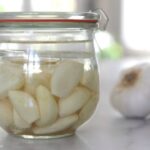Fermented Garlic Recipe
This fermented garlic recipe is more mellow and softer than raw garlic. Think of it as similar to roasted garlic, but with all it's enzymes (and other beneficial compounds) intact. You don't need any special probiotic starter to make it, and the cloves are seriously amazing in compound garlic butter, salad dressing and other recipes.
Calories
Equipment
- Jar with thick, airtight rubber seal (Fido or canning jar)
- OR - Mason jar with airlock lid
- Fermenting weight (*See notes for alternative)
Ingredients
- fresh garlic cloves (enough to fill your jar ¾ full)
- finely ground sea salt** (how much you need will depend on how much garlic you are fermenting)
- filtered water (chlorine will kill the good guys)
Instructions
- Peel the garlic cloves (trimming off the tip if desired) and place them in your clean jar. Fill the jar about ¾ full.
- Place a fermentation weight over the cloves.
- Make your brine. Exactly how much you'll need will depend on the size jar you are using. You'll want enough to fully cover the garlic cloves, plus a little more above the fermentation weight. Use a salt-to-water ratio of 5 grams by weight (about ¾ teaspoon) for each cup of filtered water.
- Secure the lid and set up the airlock if you're using one. (Here's a step-by-step photo tutorial that shows how to set up and airlock.)
- Allow the jar to ferment for 5 days to 4 weeks. If you're using a fido jar, you'll need to "burp" it (open it up) every couple of days to release the gases that build up, and if you're using an airlock you'll want to check on it periodically to make sure that the water which forms the seal hasn't evaporated. The color may change to a more caramel tint throughout the process - that's normal. Taste it throughout the fermentation process, and when it reaches a flavor that you like transfer it to the fridge. If you're using a lid with an airlock, replace it with a regular mason jar lid before storing it.
Notes
*If you don't have a fermentation weight, you can use a thin, smooth stone that has been boiled for 5-10 minutes and allowed to cool fully.
** Iodized salt contains too much iodine and will kill good bacteria, but unrefined salts like Himalayan pink salt contain minerals that good bacteria thrive in.
 Tried this recipe?
Mention @mommypotamus or tag #mommypotamus!
Tried this recipe?
Mention @mommypotamus or tag #mommypotamus!
 Tried this recipe?
Mention @mommypotamus or tag #mommypotamus!
Tried this recipe?
Mention @mommypotamus or tag #mommypotamus!
